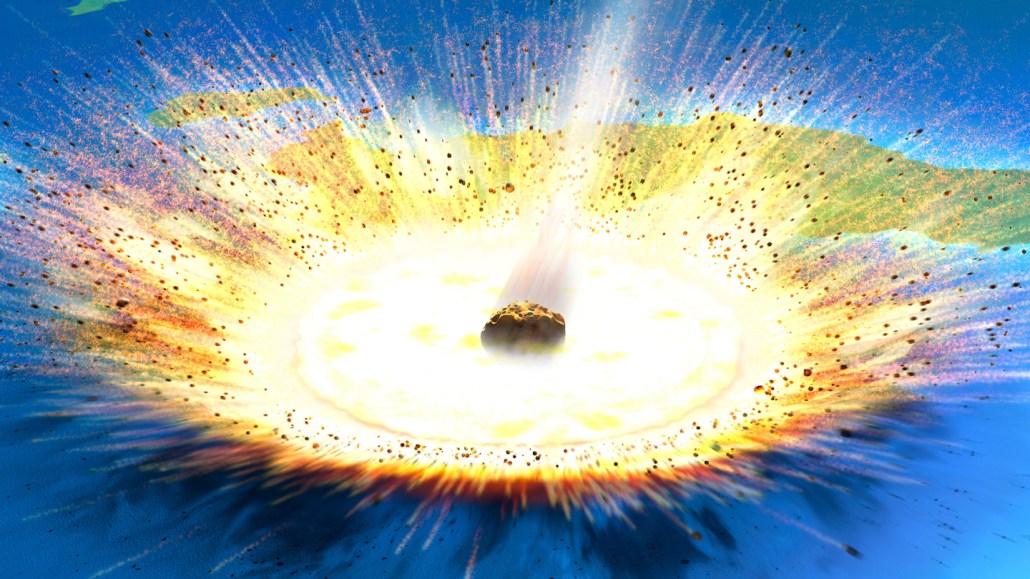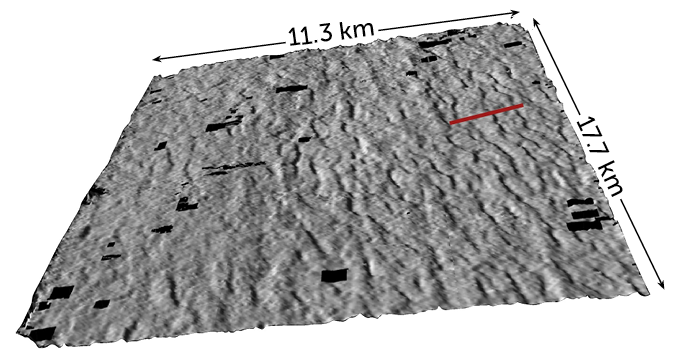Dinosaur-killing asteroid may have made Earth’s largest ripple marks
Impact created a tsunami that etched massive structures under what’s now Louisiana, study says

The Chicxulub asteroid (illustrated) slammed into Earth where today’s Yucatán Peninsula sits. That impact formed a tsunami that spread across the Gulf of Mexico that may have left giant ripples in rock under present-day Louisiana.
MARK GARLICK/SCIENCE PHOTO LIBRARY/Getty Images
The asteroid impact that slew the dinosaurs may have also indirectly sculpted the largest ripple marks ever found on Earth.
A series of ridgelike structures more than three stories high and spaced nearly two Eiffel Towers apart appear to be buried about 1,500 meters beneath central Louisiana. The oversized features are megaripples shaped by a massive tsunami generated by the Chicxulub asteroid impact, researchers report in the Sept. 15 Earth and Planetary Science Letters.
“It’s just interesting that something that happened 66 million years ago could be so well preserved, buried 5,000 feet down in the sediments of Louisiana,” says geologist Gary Kinsland of the University of Louisiana at Lafayette.
Ripple marks are repeating sequences of ridges typically found on sandy beaches or stream bottoms that form as wind or water flows over and moves loose sediment. But ripple marks on the beach are often centimeters in height, while the structures found by Kinsland’s team have an average height of 16 meters and are spaced about 600 meters apart.
The marks’ shape, size, orientation and location suggest that they formed after the Chicxulub asteroid crashed into what is today’s Yucatán Peninsula in Mexico, generating a tsunami that washed across the sediments of the Gulf of Mexico and over what is now Louisiana, which was underwater at the time (SN: 11/2/17). Despite the tsunami’s width, no one has ever found ripple marks formed by the wave before.
Geologist Kaare Egedahl initially discovered the newly described ripples while searching for coal deposits. Studying at the University of Louisiana at Lafayette at the time, Egedahl had been combing through seismic reflection data – 3-D images of buried rock and soil generated by underground sound waves — provided by the Devon Energy company. Egedahl, now at the oil and gas company Cantium, found the ripples atop a layer of rock thought to have formed from debris shaken up by the Chicxulub asteroid impact. He then shared his finding with Kinsland.

“I knew where that layer was from in geologic time, and I knew what happened there,” Kinsland says. “I knew there should be a tsunami.”
The supposed ripple marks were preserved all this time thanks to the depth at which they formed underwater, Kinsland says. Other studies suggest that the region of present-day Louisiana in which the ripples took shape was 60 meters below the sea surface at the time. At that depth, the ripples would have been beyond the reach of tumultuous storm activity that could have erased them. Then, over millions of years, the marks were slowly buried by other sediments.
A smaller, analogous set of structures may exist off the east coast of Japan. There, a repeating sequence of underwater dunes was reported to have appeared after the 2011 Tohoku earthquake and tsunami. Those dunes look nearly identical to the ripple marks buried beneath Louisiana, except for their size, Kinsland says, supporting the notion that the taller structures were also produced by a tsunami, though one of a much larger magnitude.
Still, there is contention over whether the features beneath Louisiana really are megaripples formed by the Chicxulub tsunami.
“It’s hard to see how such a high-energy event could form ripple marks because they are usually associated with much calmer environments,” says sedimentologist Pedro J.M. Costa of the Universidade de Coimbra in Portugal. And ripple marks typically form from frequent and recurring wave motion, while tsunamis don’t have many waves, he explains. Costa, who is an expert on tsunami deposits, says that reconstructing the lay of the seafloor at that time of the impact and conducting experiments could help unravel the origins of the structures found by Kinsland’s team.
This new work is important because it opens a discussion, Costa says. “Maybe [the Chicxulub impact was] such a high-magnitude event that what we see in normal tsunami events don’t apply to this one.”






